An Innovative Hunter-Prey-Based Optimization for Electrically Based Single-, Double-, and Triple-Diode Models of Solar Photovoltaic Systems
Abstract
1. Introduction
1.1. Motivation
1.2. Literature Survey of Related Work
1.3. Research Gap
1.4. Paper Contribution
- A promising algorithm is demonstrated in the field of photovoltaic technologies, modelling with real applications on a commercial STM6-40/36 module and RTC France cell;
- The simulated results demonstrate that the developed PV system equivalent model relying on the HPO technique is extremely efficient and produces superior outcomes when compared to other reported techniques;
- The convergence rate for the proposed HPO is great, with a high speed in focusing the search around the area of the global optimization of the minimum RMSE;
- The proposed HPO technique provides high accuracy in extracting the electrical PV parameters with significant coincidence between the simulated and experimental I–V and P–V characteristics.
1.5. Key Segments of the Paper
2. Mathematical Model of the Hunter–Prey-Based Optimization
3. Mathematical Model of the Electrical Representations of Solar PV Systems
3.1. Single-Diode Model
3.2. Double-Diode Model
3.3. Photovoltaic Triple-Diode Model
3.4. PV Modules Handling
3.5. Objective Function Formulation
4. Simulation Results
4.1. Simulation Results for STM6_40/36 PV Module
4.1.1. Case 1: Single-Diode Model
4.1.2. Case 2: Double-diode Model of STM6_40/36 PV Module
4.1.3. Case 3: Triple-Diode Model of STM6_40/36 PV Module
4.2. Simulation Results for RTC France Silicon Cell
5. Conclusions
Author Contributions
Funding
Data Availability Statement
Conflicts of Interest
References
- El-Ela, A.A.A.; El-Seheimy, R.A.; Shaheen, A.M.; Wahbi, W.A.; Mouwafi, M.T. PV and Battery Energy Storage Integration in Distribution Networks Using Equilibrium Algorithm. J. Energy Storage 2021, 42, 103041. [Google Scholar] [CrossRef]
- Bana, S.; Saini, R.P. Identification of Unknown Parameters of a Single Diode Photovoltaic Model Using Particle Swarm Optimization with Binary Constraints. Renew. Energy 2017, 101, 1299–1310. [Google Scholar] [CrossRef]
- El-Ela, A.A.A.; El-Sehiemy, R.A.; Shaheen, A.M.; Ellien, A.R. Review on Active Distribution Networks with Fault Current Limiters and Renewable Energy Resources. Energies 2022, 15, 7648. [Google Scholar] [CrossRef]
- Xiong, G.; Zhang, J.; Yuan, X.; Shi, D.; He, Y.; Yao, G. Parameter Extraction of Solar Photovoltaic Models by Means of a Hybrid Differential Evolution with Whale Optimization Algorithm. Sol. Energy 2018, 176. [Google Scholar] [CrossRef]
- Khanna, V.; Das, B.K.; Bisht, D.; Vandana; Singh, P.K. A Three Diode Model for Industrial Solar Cells and Estimation of Solar Cell Parameters Using PSO Algorithm. Renew. Energy 2015, 78, 105–113. [Google Scholar] [CrossRef]
- El-Ela, A.A.A.; El-Sehiemy, R.A.; Shaheen, A.M.; Wahbi, W.A.; Mouwafi, M.T. A Multi-Objective Equilibrium Optimization for Optimal Allocation of Batteries in Distribution Systems with Lifetime Maximization. J. Energy Storage 2022, 55, 10597. [Google Scholar]
- Zaky, A.A.; El Sehiemy, R.A.; Rashwan, Y.I.; Elhossieni, M.A.; Gkini, K.; Kladas, A.; Falaras, P. Optimal Performance Emulation of PSCs Using the Elephant Herd Algorithm Associated with Experimental Validation. ECS J. Solid State Sci. Technol. 2019, 8, Q249–Q255. [Google Scholar] [CrossRef]
- Qais, M.H.; Hasanien, H.M.; Alghuwainem, S. Transient Search Optimization for Electrical Parameters Estimation of Photovoltaic Module Based on Datasheet Values. Energy Convers. Manag. 2020, 214. [Google Scholar] [CrossRef]
- Hasanien, H.M. Shuffled Frog Leaping Algorithm for Photovoltaic Model Identification. IEEE Trans. Sustain. Energy 2015, 6, 509–515. [Google Scholar] [CrossRef]
- Kanimozhi, G. Harish Kumar Modeling of Solar Cell under Different Conditions by Ant Lion Optimizer with LambertW Function. Appl. Soft Comput. J. 2018, 71, 141–151. [Google Scholar] [CrossRef]
- Lin, P.; Cheng, S.; Yeh, W.; Chen, Z.; Wu, L. Parameters Extraction of Solar Cell Models Using a Modified Simplified Swarm Optimization Algorithm. Sol. Energy 2017, 144, 594–603. [Google Scholar] [CrossRef]
- Subudhi, B.; Pradhan, R. Bacterial Foraging Optimization Approach to Parameter Extraction of a Photovoltaic Module. IEEE Trans. Sustain. Energy 2018, 9, 381–389. [Google Scholar] [CrossRef]
- Liang, J.; Qiao, K.; Yu, K.; Ge, S.; Qu, B.; Xu, R.; Li, K. Parameters Estimation of Solar Photovoltaic Models via a Self-Adaptive Ensemble-Based Differential Evolution. Sol. Energy 2020, 207, 336–346. [Google Scholar] [CrossRef]
- Guo, L.; Meng, Z.; Sun, Y.; Wang, L. Parameter Identification and Sensitivity Analysis of Solar Cell Models with Cat Swarm Optimization Algorithm. Energy Convers. Manag. 2016, 108, 520–528. [Google Scholar] [CrossRef]
- Abbassi, A.; Abbassi, R.; Heidari, A.A.; Oliva, D.; Chen, H.; Habib, A.; Jemli, M.; Wang, M. Parameters Identification of Photovoltaic Cell Models Using Enhanced Exploratory Salp Chains-Based Approach. Energy 2020, 198, 117333. [Google Scholar] [CrossRef]
- Chen, X.; Tianfield, H.; Du, W.; Liu, G. Biogeography-Based Optimization with Covariance Matrix Based Migration. Appl. Soft Comput. 2016, 45, 71–85. [Google Scholar] [CrossRef]
- Abbassi, R.; Abbassi, A.; Heidari, A.A.; Mirjalili, S. An Efficient Salp Swarm-Inspired Algorithm for Parameters Identification of Photovoltaic Cell Models. Energy Convers. Manag. 2019, 179, 362–372. [Google Scholar] [CrossRef]
- Ebrahimi, S.M.; Salahshour, E.; Malekzadeh, M. Francisco Gordillo Parameters Identification of PV Solar Cells and Modules Using Flexible Particle Swarm Optimization Algorithm. Energy 2019, 179, 358–372. [Google Scholar] [CrossRef]
- Gao, X.; Cui, Y.; Hu, J.; Xu, G.; Wang, Z.; Qu, J.; Wang, H. Parameter Extraction of Solar Cell Models Using Improved Shuffled Complex Evolution Algorithm. Energy Convers. Manag. 2018, 157, 460–479. [Google Scholar] [CrossRef]
- Xiong, G.; Zhang, J.; Shi, D.; He, Y. Parameter Extraction of Solar Photovoltaic Models Using an Improved Whale Optimization Algorithm. Energy Convers. Manag. 2018, 174. [Google Scholar] [CrossRef]
- Ram, J.P.; Babu, T.S.; Dragicevic, T.; Rajasekar, N. A New Hybrid Bee Pollinator Flower Pollination Algorithm for Solar PV Parameter Estimation. Energy Convers. Manag. 2017, 135, 463–476. [Google Scholar] [CrossRef]
- Yu, K.; Qu, B.; Yue, C.; Ge, S.; Chen, X.; Liang, J. A Performance-Guided JAYA Algorithm for Parameters Identification of Photovoltaic Cell and Module. Appl. Energy 2019, 237, 241–257. [Google Scholar] [CrossRef]
- Shaheen, A.M.; El-Seheimy, R.A.; Xiong, G.; Elattar, E.; Ginidi, A.R. Parameter Identification of Solar Photovoltaic Cell and Module Models via Supply Demand Optimizer. Ain Shams Eng. J. 2022, 13, 101705. [Google Scholar] [CrossRef]
- Ginidi, A.R.; Shaheen, A.M.; El-Sehiemy, R.A.; Elattar, E. Supply Demand Optimization Algorithm for Parameter Extraction of Various Solar Cell Models. Energy Rep. 2021, 7, 5772–5794. [Google Scholar] [CrossRef]
- Saadaoui, D.; Elyaqouti, M.; Assalaou, K.; Ben hmamou, D.; Lidaighbi, S. Parameters Optimization of Solar PV Cell/Module Using Genetic Algorithm Based on Non-Uniform Mutation. Energy Convers. Manag. X 2021, 12, 100129. [Google Scholar] [CrossRef]
- Shaheen, A.; El-Sehiemy, R.; El-Fergany, A.; Ginidi, A. Representations of Solar Photovoltaic Triple-Diode Models Using Artificial Hummingbird Optimizer. Energy Sources Part A Recover. Util. Environ. Eff. 2022, 44, 8787–8810. [Google Scholar] [CrossRef]
- Li, C.; Niu, Z.; Song, Z.; Li, B.; Fan, J.; Liu, P.X. A Double Evolutionary Learning Moth-Flame Optimization for Real-Parameter Global Optimization Problems. IEEE Access 2018, 6, 76700–76727. [Google Scholar] [CrossRef]
- Ramadan, A.E.; Kamel, S.; Khurshaid, T.; Oh, S.R.; Rhee, S.B. Parameter Extraction of Three Diode Solar Photovoltaic Model Using Improved Grey Wolf Optimizer. Sustainability 2021, 13, 6963. [Google Scholar] [CrossRef]
- Long, W.; Cai, S.; Jiao, J.; Xu, M.; Wu, T. A New Hybrid Algorithm Based on Grey Wolf Optimizer and Cuckoo Search for Parameter Extraction of Solar Photovoltaic Models. Energy Convers. Manag. 2020, 203, 112243. [Google Scholar] [CrossRef]
- Prasanthi, A.; Shareef, H.; Errouissi, R.; Asna, M.; Wahyudie, A. Quantum Chaotic Butterfly Optimization Algorithm with Ranking Strategy for Constrained Optimization Problems. IEEE Access 2021, 9, 114587–114608. [Google Scholar] [CrossRef]
- Liang, J.; Ge, S.; Qu, B.; Yu, K.; Liu, F.; Yang, H.; Wei, P.; Li, Z. Classified Perturbation Mutation Based Particle Swarm Optimization Algorithm for Parameters Extraction of Photovoltaic Models. Energy Convers. Manag. 2020, 203, 112138. [Google Scholar] [CrossRef]
- Arandian, B.; Eslami, M.; Khalid, S.A.; Khan, B.; Sheikh, U.U.; Akbari, E.; Mohammed, A.H. An Effective Optimization Algorithm for Parameters Identification of Photovoltaic Models. IEEE Access 2022, 10, 34069–34084. [Google Scholar] [CrossRef]
- Gupta, J.; Nijhawan, P.; Ganguli, S. Parameter Extraction of Solar PV Cell Models Using Novel Metaheuristic Chaotic Tunicate Swarm Algorithm. Int. Trans. Electr. Energy Syst. 2021, 31, e13244. [Google Scholar] [CrossRef]
- Ginidi, A.R.; Shaheen, A.M.; El-Sehiemy, R.A.; Hasanien, H.M.; Al-Durra, A. Estimation of Electrical Parameters of Photovoltaic Panels Using Heap-Based Algorithm. IET Renew. Power Gener. 2022, 16, 2292–2312. [Google Scholar] [CrossRef]
- Eslami, M.; Akbari, E.; Seyed Sadr, S.T.; Ibrahim, B.F. A Novel Hybrid Algorithm Based on Rat Swarm Optimization and Pattern Search for Parameter Extraction of Solar Photovoltaic Models. Energy Sci. Eng. 2022, 10, 2689–2713. [Google Scholar] [CrossRef]
- Li, S.; Gong, W.; Yan, X.; Hu, C.; Bai, D.; Wang, L. Parameter Estimation of Photovoltaic Models with Memetic Adaptive Differential Evolution. Sol. Energy 2019, 190, 465–474. [Google Scholar] [CrossRef]
- Oliva, D.; Cuevas, E.; Pajares, G. Parameter Identification of Solar Cells Using Artificial Bee Colony Optimization. Energy 2014, 72, 93–102. [Google Scholar] [CrossRef]
- Chen, X.; Yu, K. Hybridizing Cuckoo Search Algorithm with Biogeography-Based Optimization for Estimating Photovoltaic Model Parameters. Sol. Energy 2019, 180, 192–206. [Google Scholar] [CrossRef]
- Chin, V.J.; Salam, Z.; Ishaque, K. Cell Modelling and Model Parameters Estimation Techniques for Photovoltaic Simulator Application: A Review. Appl. Energy 2015, 154, 500–519. [Google Scholar] [CrossRef]
- Wolpert, D.H.; Macready, W.G. No Free Lunch Theorems for Optimization. IEEE Trans. Evol. Comput. 1997, 1. [Google Scholar] [CrossRef]
- Naruei, I.; Keynia, F.; Sabbagh Molahosseini, A. Hunter–Prey Optimization: Algorithm and Applications. Soft Comput. 2022, 26, 1279–1314. [Google Scholar] [CrossRef]
- Ortiz-Conde, A.; Lugo-Muñoz, D.; García-Sánchez, F.J. An Explicit Multiexponential Model as an Alternative to Traditional Solar Cell Models with Series and Shunt Resistances. IEEE J. Photovolt. 2012, 2, 261–268. [Google Scholar] [CrossRef]
- Qais, M.H.; Hasanien, H.M.; Alghuwainem, S. Identification of Electrical Parameters for Three-Diode Photovoltaic Model Using Analytical and Sunflower Optimization Algorithm. Appl. Energy 2019, 250, 109–117. [Google Scholar] [CrossRef]
- Fossum, J.G.; Lindholm, F.A. Theory of Grain-Boundary and Intragrain Recombination Currents in Polysilicon p-n-Junction Solar Cells. IEEE Trans. Electron Devices 1980, 27, 692–700. [Google Scholar] [CrossRef]
- Koohi-Kamali, S.; Rahim, N.A.; Mokhlis, H.; Tyagi, V.V. Photovoltaic Electricity Generator Dynamic Modeling Methods for Smart Grid Applications: A Review. Renew. Sustain. Energy Rev. 2016, 57, 131–172. [Google Scholar] [CrossRef]
- Chin, V.J.; Salam, Z. Coyote Optimization Algorithm for the Parameter Extraction of Photovoltaic Cells. Sol. Energy 2019, 194, 656–670. [Google Scholar] [CrossRef]
- Tong, N.T.; Pora, W. A Parameter Extraction Technique Exploiting Intrinsic Properties of Solar Cells. Appl. Energy 2016, 176, 104–115. [Google Scholar] [CrossRef]
- Ginidi, A.; Ghoneim, S.M.; Elsayed, A.; El-Sehiemy, R.; Shaheen, A.; El-Fergany, A. Gorilla Troops Optimizer for Electrically Based Single and Double-Diode Models of Solar Photovoltaic Systems. Sustainability 2021, 13, 9459. [Google Scholar] [CrossRef]
- Kang, T.; Yao, J.; Jin, M.; Yang, S.; Duong, T. A Novel Improved Cuckoo Search Algorithm for Parameter Estimation of Photovoltaic (PV) Models. Energies 2018, 11, 1060. [Google Scholar] [CrossRef]
- Shaheen, A.M.; Ginidi, A.R.; El-Sehiemy, R.A.; Ghoneim, S.S.M. A Forensic-Based Investigation Algorithm for Parameter Extraction of Solar Cell Models. IEEE Access 2021, 9, 1–20. [Google Scholar] [CrossRef]
- Chin, V.J.; Salam, Z. A New Three-Point-Based Approach for the Parameter Extraction of Photovoltaic Cells. Appl. Energy 2019, 237, 519–533. [Google Scholar] [CrossRef]
- Ben Messaoud, R. Extraction of Uncertain Parameters of a Single-Diode Model for a Photovoltaic Panel Using Lightning Attachment Procedure Optimization. J. Comput. Electron. 2020, 19, 1192–1202. [Google Scholar] [CrossRef]
- Rezaee Jordehi, A. Enhanced Leader Particle Swarm Optimisation (ELPSO): An Efficient Algorithm for Parameter Estimation of Photovoltaic (PV) Cells and Modules. Sol. Energy 2018, 159, 78–87. [Google Scholar] [CrossRef]
- Lekouaghet, B.; Boukabou, A.; Boubakir, C. Estimation of the Photovoltaic Cells/Modules Parameters Using an Improved Rao-Based Chaotic Optimization Technique. Energy Convers. Manag. 2021, 229, 113722. [Google Scholar] [CrossRef]
- Deotti, L.M.P.; Pereira, J.L.R.; Silva Júnior, I.C. da Parameter Extraction of Photovoltaic Models Using an Enhanced Lévy Flight Bat Algorithm. Energy Convers. Manag. 2020, 221, 113114. [Google Scholar] [CrossRef]
- Yousri, D.; Thanikanti, S.B.; Allam, D.; Ramachandaramurthy, V.K.; Eteiba, M.B. Fractional Chaotic Ensemble Particle Swarm Optimizer for Identifying the Single, Double, and Three Diode Photovoltaic Models’ Parameters. Energy 2020, 195, 116979. [Google Scholar] [CrossRef]
- Shaheen, A.M.; Elsayed, A.M.; Ginidi, A.R.; El-Sehiemy, R.A.; Elattar, E. Enhanced Social Network Search Algorithm with Powerful Exploitation Strategy for PV Parameters Estimation. Energy Sci. Eng. 2022, 10, 1398–1417. [Google Scholar] [CrossRef]
- Niu, Q.; Zhang, L.; Li, K. A Biogeography-Based Optimization Algorithm with Mutation Strategies for Model Parameter Estimation of Solar and Fuel Cells. Energy Convers. Manag. 2014, 86, 1173–1185. [Google Scholar] [CrossRef]
- Wang, W.; Wu, J.M.; Liu, J.H. A Particle Swarm Optimization Based on Chaotic Neighborhood Search to Avoid Premature Convergence. 2009 Third International Conference on Genetic and Evolutionary Computing, Guilin, China, 14–17 October 2009; pp. 633–636. [Google Scholar] [CrossRef]
- Wang, R.; Zhan, Y.; Zhou, H. Application of Artificial Bee Colony in Model Parameter Identification of Solar Cells. Energies 2015, 8, 7563–7581. [Google Scholar] [CrossRef]
- Askarzadeh, A.; Rezazadeh, A. Parameter Identification for Solar Cell Models Using Harmony Search-Based Algorithms. Sol. Energy 2012, 86, 3241–3249. [Google Scholar] [CrossRef]
- Yu, K.; Liang, J.J.; Qu, B.Y.; Chen, X.; Wang, H. Parameters Identification of Photovoltaic Models Using an Improved JAYA Optimization Algorithm. Energy Convers. Manag. 2017, 150, 742–753. [Google Scholar] [CrossRef]
- Hu, Z.; Gong, W.; Li, S. Reinforcement Learning-Based Differential Evolution for Parameters Extraction of Photovoltaic Models. Energy Rep. 2021, 7, 916–928. [Google Scholar] [CrossRef]
- Sarhan, S.; Shaheen, A.M.; El-Sehiemy, R.A.; Gafar, M. Enhanced Teaching Learning-Based Algorithm for Fuel Costs and Losses Minimization in AC-DC Systems. Mathematics 2022, 10, 2337. [Google Scholar] [CrossRef]

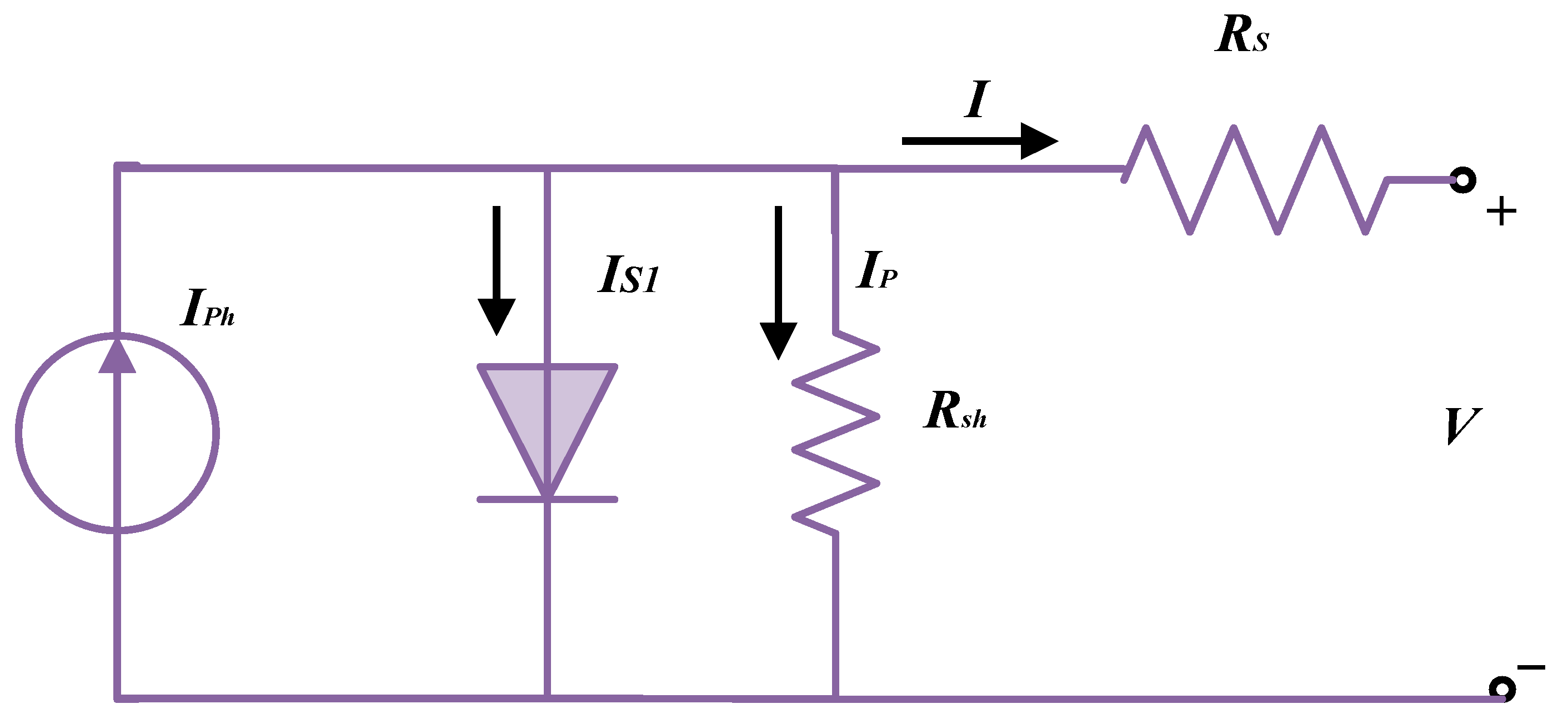
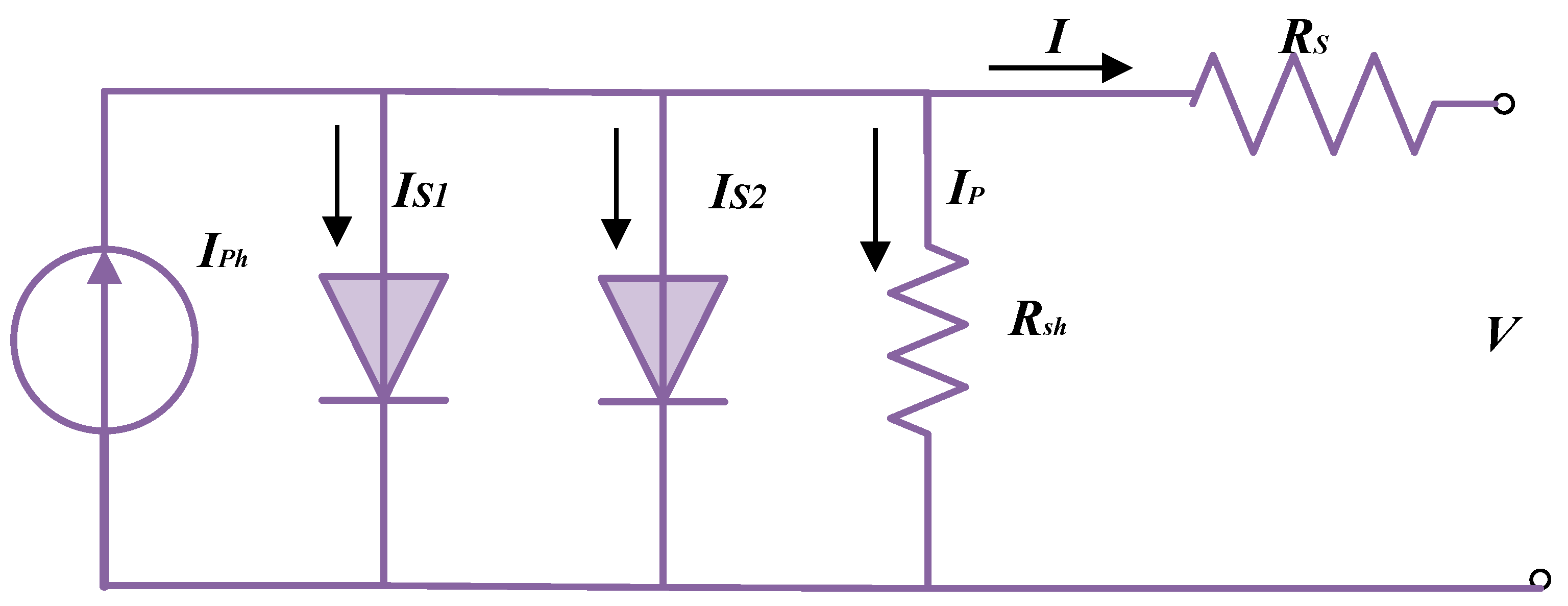
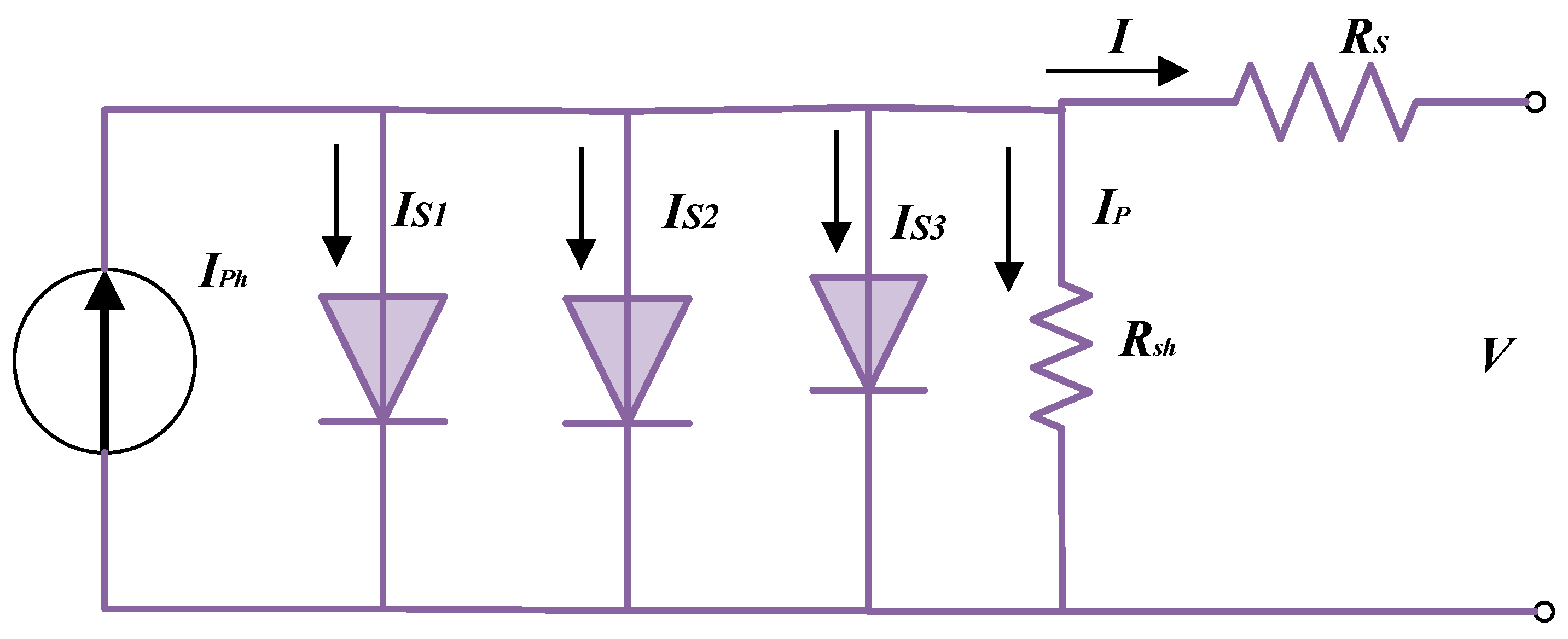


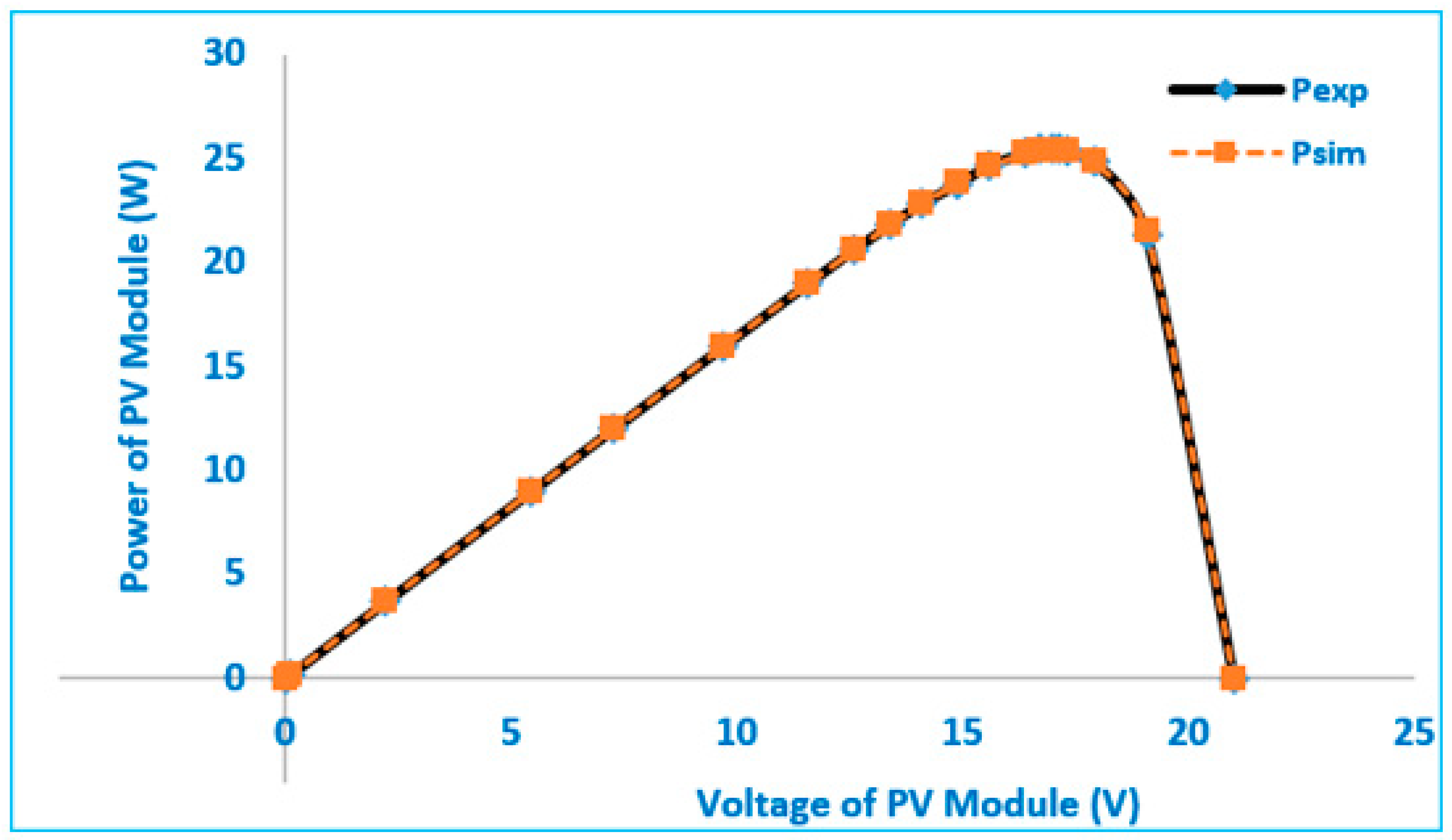
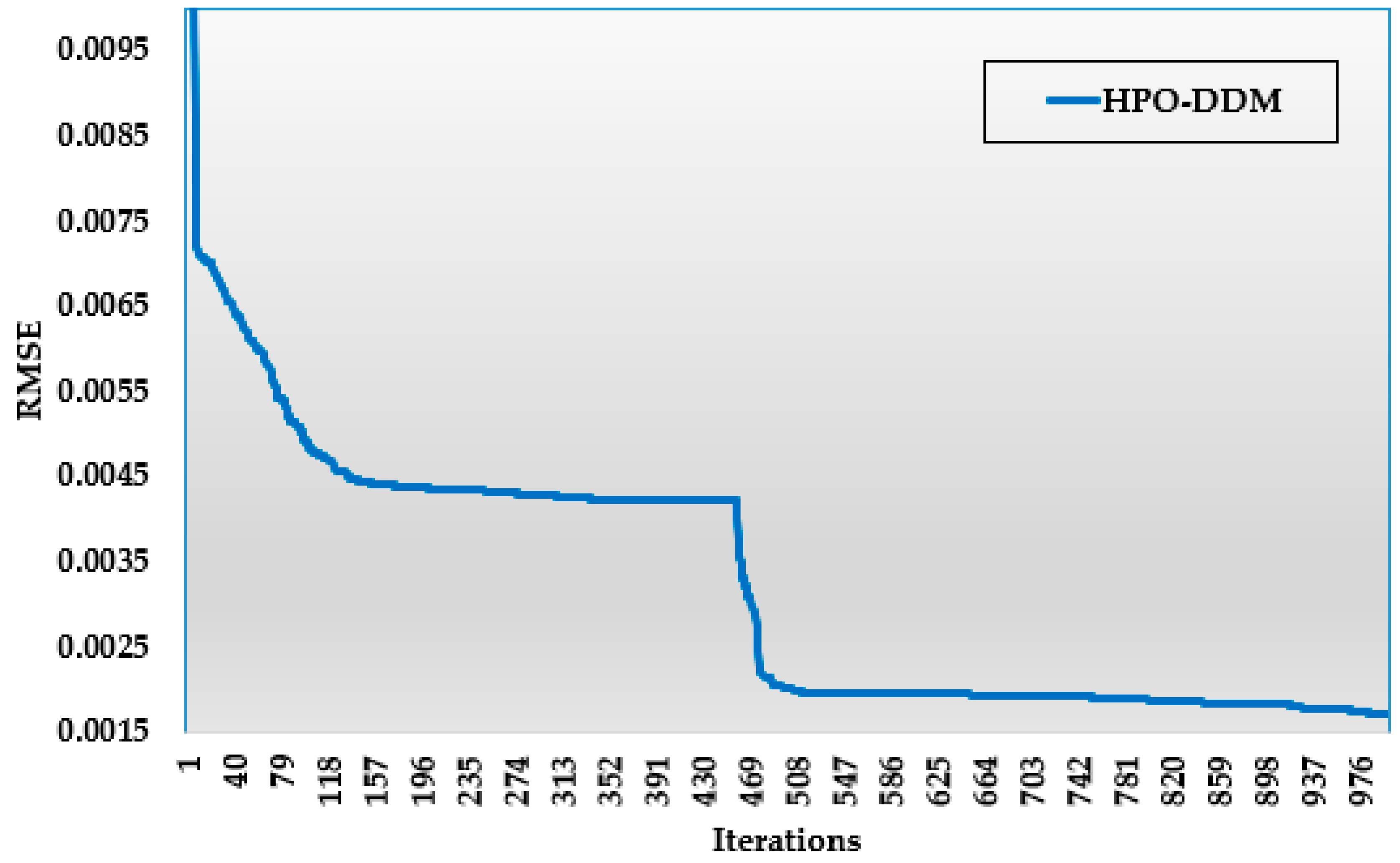
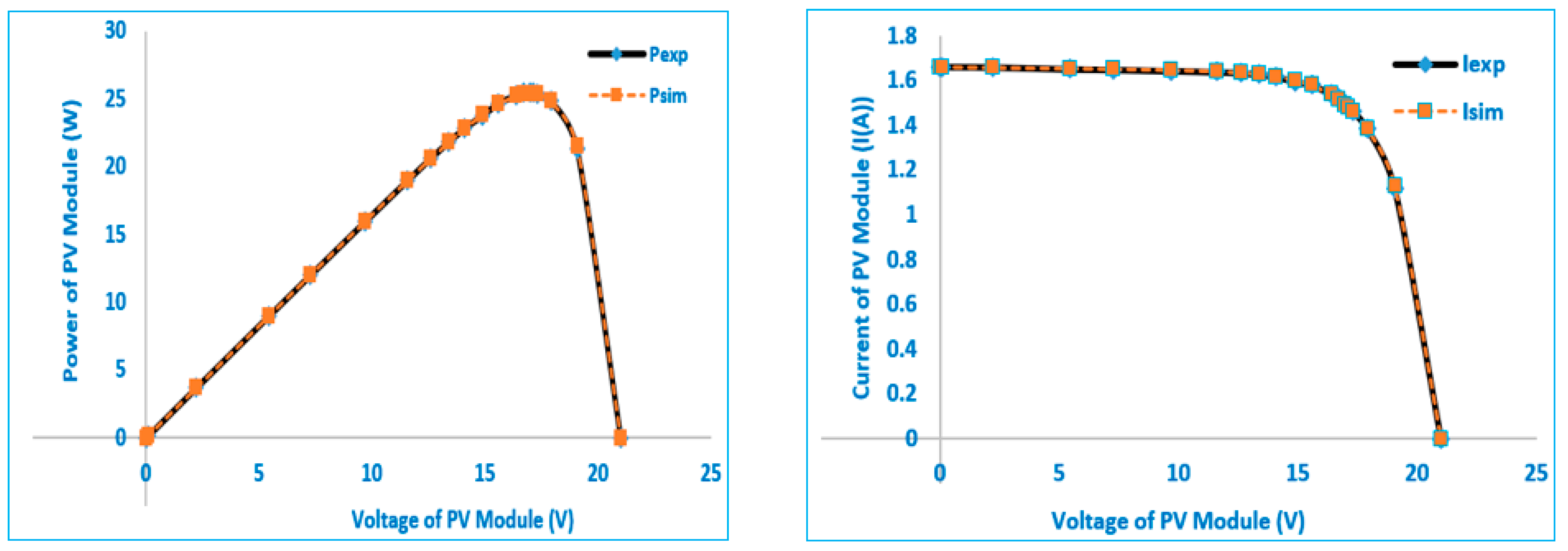

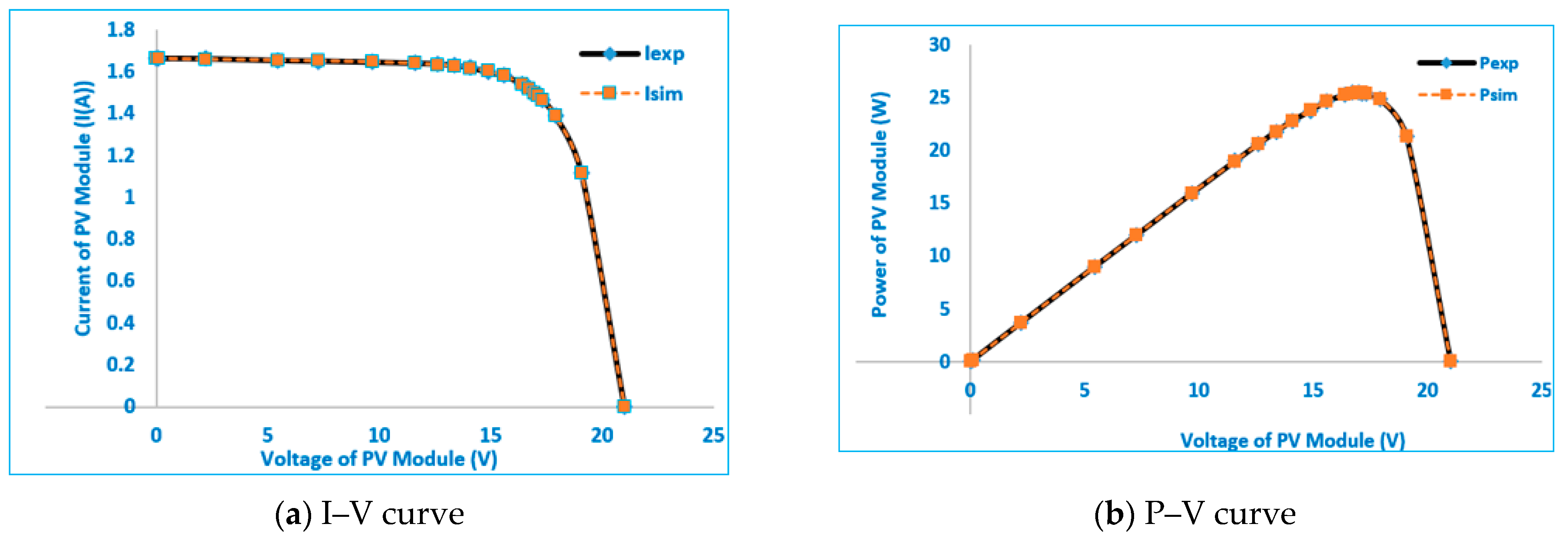
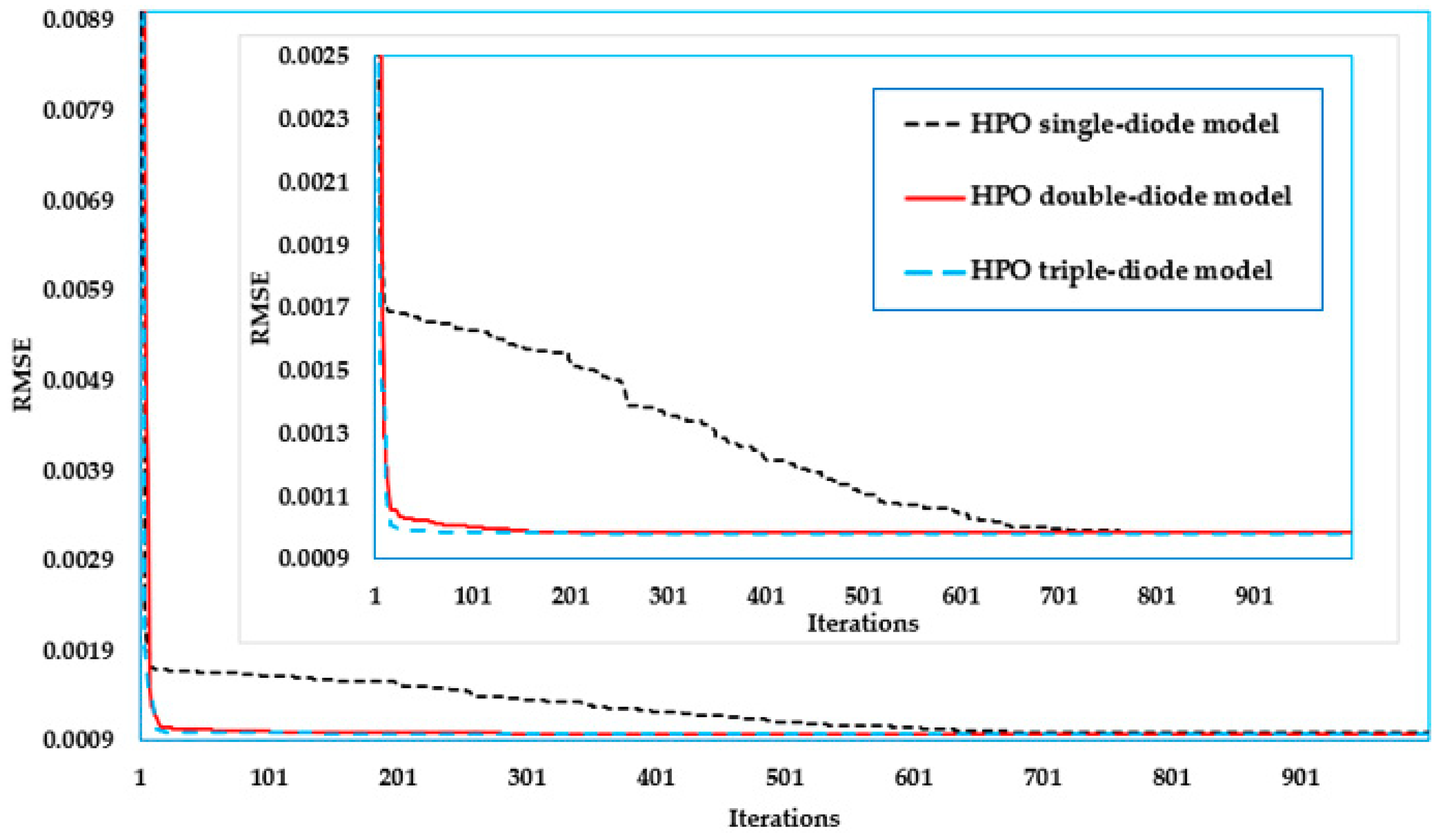
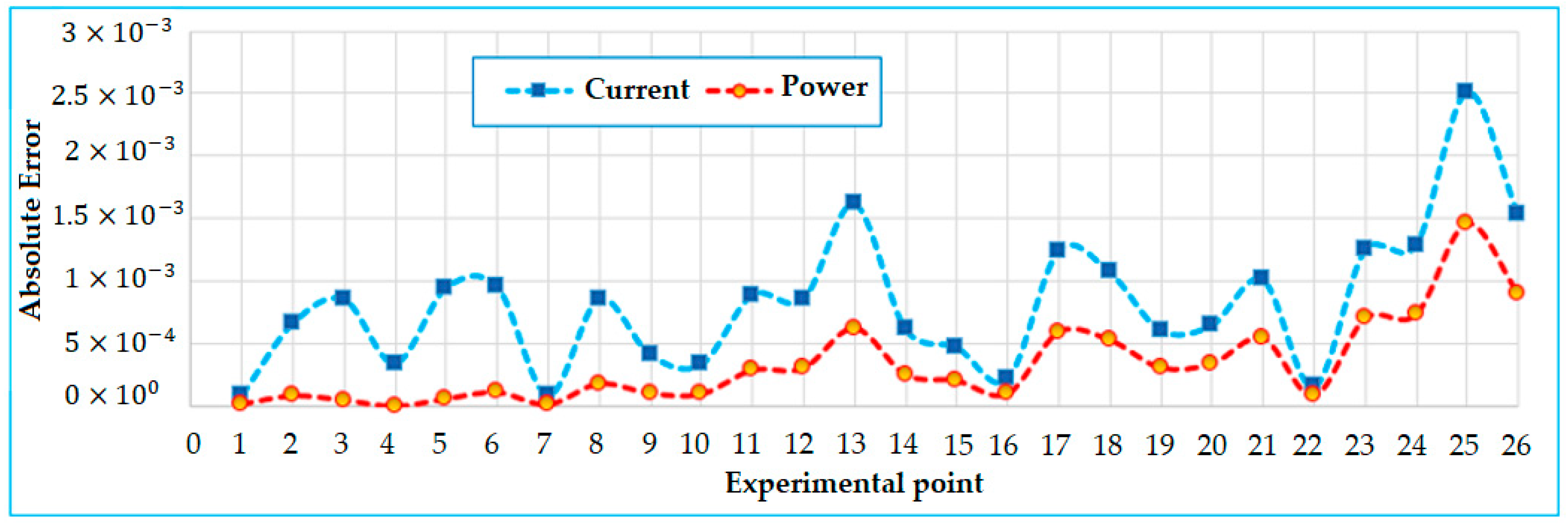
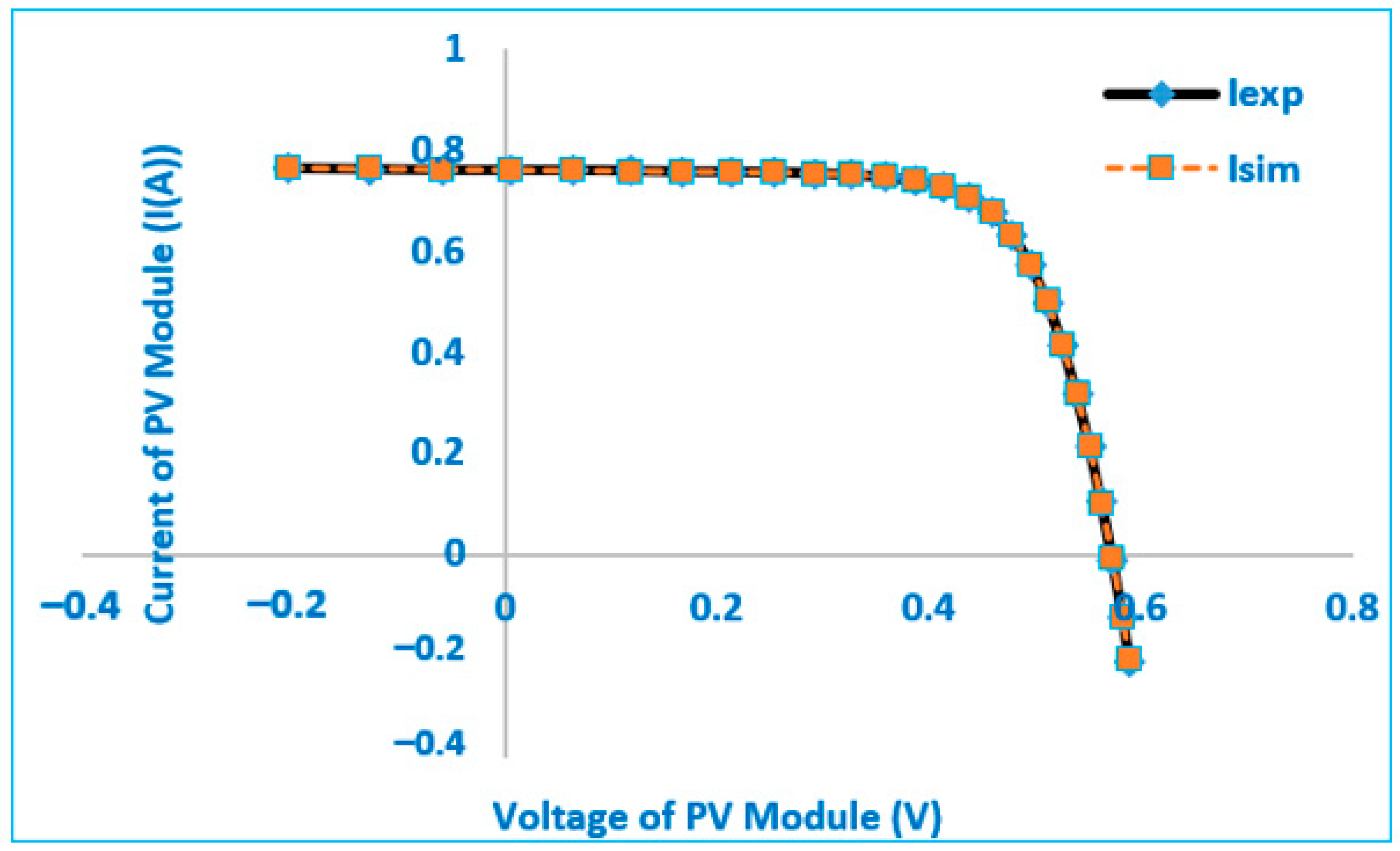
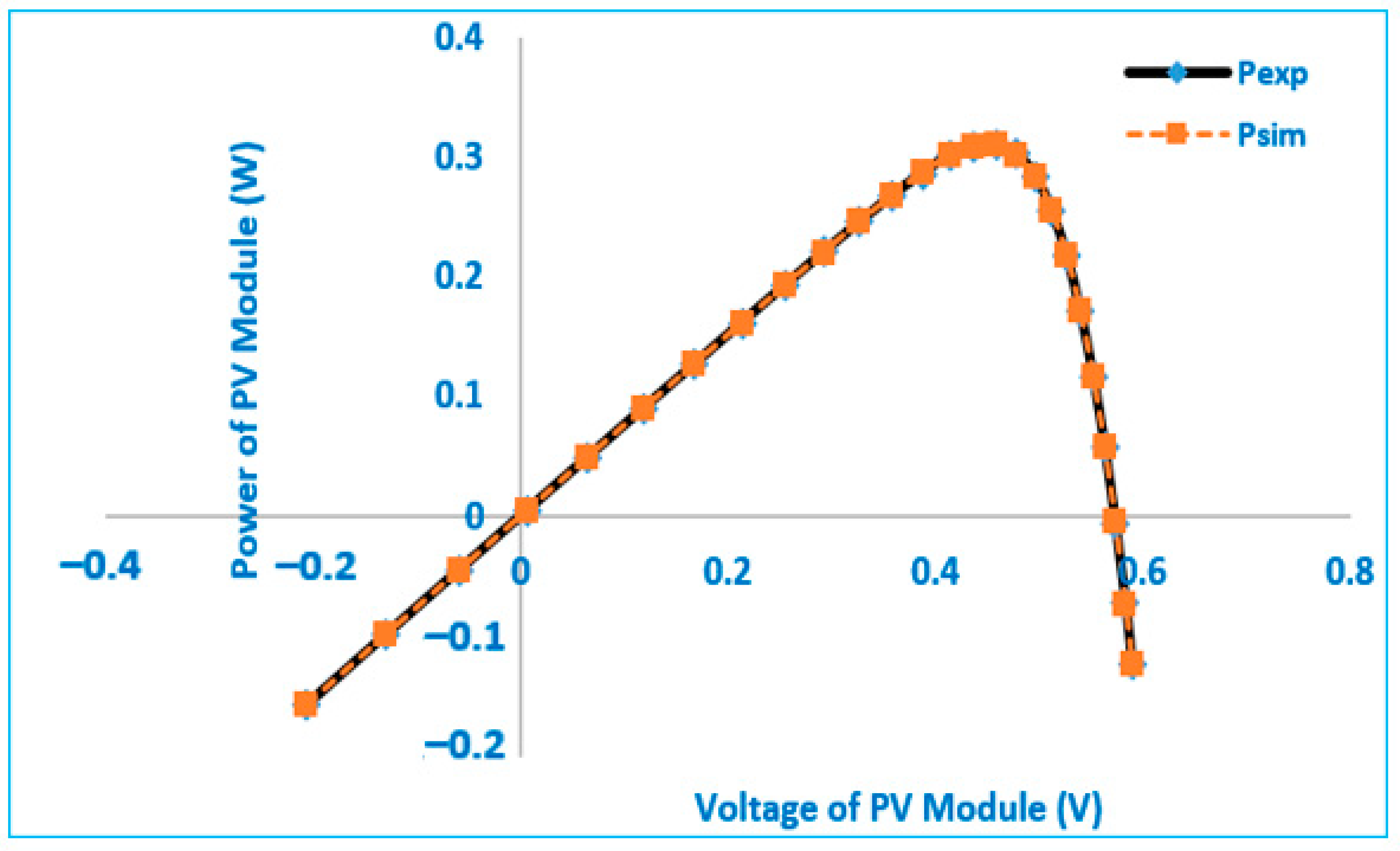
| Parameter | STM6-40/36 PV Module | RTC France PV Cell | ||
|---|---|---|---|---|
| lb | ub | lb | ub | |
| IPh (A) | 0 | 2 | 0 | 1 |
| RS (Ω) | 0 | 0.36 | 0 | 0.5 |
| 1 | 2 | 1 | 2 | |
| Rsh (Ω) | 0 | 100 | 0 | 100 |
| (μA) | 0 | 50 | 0 | 1 |
| Optimizer | IPh (A) | RS (Ω) | Rsh (Ω) | RMSE | Improvement % | ||
|---|---|---|---|---|---|---|---|
| Proposed HPO | 1.663905 | 1.74 | 0.004275 | 15.92749 | 1.520269 | 1.729814 × 10−3 | - |
| EO [48] | 1.663629 | 1.78 | 0.004205 | 16.24408 | 1.523146 | 1.733 × 10−3 | 0.1838 |
| MPA [48] | 1.65702 | 2.46 | 0.003831 | 31.50673 | 1.559041 | 3.496 × 10−3 | 50.5202 |
| EMPA [48] | 1.663418 | 2.03 | 0.003788 | 16.878 | 1.537713 | 1.769 × 10−3 | 2.2151 |
| GTO [48] | 1.663905 | 1.74 | 0.004274 | 15.92829 | 1.520303 | 1.73 × 10−3 | 0.0108 |
| HBA [48] | 1.661527 | 5.51 | 0.00001 | 23.6426 | 1.658694 | 3.33 × 10−3 | 48.0536 |
| JFS [48] | 1.662589 | 1.84 | 0.004105 | 16.96607 | 1.526795 | 1.807 × 10−3 | 4.2715 |
| ImCSA [49] | 1.663971 | 2 | 0.002914 | 15.84051 | 1.5335 | 1.794 × 10−3 | 3.5778 |
| FBI [50] | 1.66391 | 1.74 | 0.004281 | 15.91743 | 1.520073 | 1.73 × 10−3 | 0.0108 |
| ISCE [19] | 1.66390478 | 1.74 | 0.004274 | 15.9283 | 1.5203 | 1.73 × 10−3 | 0.0108 |
| BHCS [38] | 1.6639 | 1.74 | 0.00427 | 15.9283 | 1.5203 | 1.73 × 10−3 | 0.0108 |
| TPBA [51] | 1.6632 | 2.77 | 0.004186 | 16.7328 | 1.5656 | 1.774 × 10−3 | 2.4908 |
| SA [52] | 1.6609 | 5.90 | 0.0049499 | 26.7742 | 1.66602 | 3.399 × 10−3 | 49.1081 |
| Optimizer | IPh (A) | RS (Ω) | Rsh (Ω) | RMSE | Improvement % | ||||
|---|---|---|---|---|---|---|---|---|---|
| HPO | 1.663702 | 4.06 | 5.57 × 10−4 | 0.008726 | 17.82614 | 1.688851 | 1 | 1.696271 × 10−3 | - |
| EPSO [53] | 1.6648 | 16.70 | 6.21 × 10−6 | 0.5000 | 16.858 | 1.16649 | 1.87067 | 1.8307 × 10−3 | 7.3430 |
| LCROA [54] | 1.6637 | 72.2 | 3.28 × 10−6 | 0.16717 | 16.7419 | 1.5739 | 2.000 | 1.712 × 10−3 | 0.9187 |
| BA [55] | 1.637941 | 1.59 | 3.94 × 10−5 | 0.003887 | 24.6958 | 1.504536 | 1.4783 | 2.194577 × 10−2 | 92.2706 |
| DBA [55] | 1.663860 | 1.80 | 3.66 × 10−6 | 0.004167 | 16.066503 | 1.524098 | 1.43939 | 1.731960 × 10−3 | 2.0606 |
| NBA [55] | 1.662865 | 6.60 | 1.61 × 10−6 | 0.004653 | 16.694049 | 1.678806 | 1.511867 | 1.82684 × 10−3 | 7.1473 |
| FC-EPSO [56] | 1.6634 | 1.85 | 9.72 × 10−5 | 0.01101 | 16.5914 | 1.5818 | 1.5445 | 1.772 × 10−3 | 4.2736 |
| Optimizer | Min | Improvement % | Mean | Improvement % | Max | Improvement % | Std | Improvement % |
|---|---|---|---|---|---|---|---|---|
| HPO | 0.001696271 | - | 0.003222066 | - | 0.003329899 | - | 0.000410222 | - |
| BA [55] | 2.1946 × 10−2 | 2.0250 | 0.092023 | 8.8801 | 0.01448059 | 1.1151 | 2.407 × 10−2 | 2.3660 |
| DBA [55] | 1.7319 × 10−3 | 0.0036 | 0.004934 | 0.1712 | 0.01372796 | 1.0398 | 2.893 × 10−3 | 0.2483 |
| NBA [55] | 1.8268 × 10−3 | 0.0131 | 0.0041404 | 0.0918 | 0.007598 | 0.4268 | 1.430 × 10−3 | 0.1020 |
| LCROA [54] | 1.712 × 10−3 | 0.0016 | − | - | − | - | − | - |
| FC-EPSO [56] | 1.772 × 10−3 | 0.0076 | − | - | − | - | − | - |
| EPSO [53] | 1.8307 × 10−3 | 0.0134 | − | - | − | - | − | - |
| Point | Vexp | Iexp | Isim | Pexp | Psim | Absolut IAE | Absolut PAE |
|---|---|---|---|---|---|---|---|
| 1 | 0 | 1.663 | 1.66155158 | 0 | 0 | 0.00144842 | 0 |
| 2 | 0.118 | 1.663 | 1.661412044 | 0.196234 | 0.196047 | 0.001587956 | 0.000187379 |
| 3 | 2.237 | 1.661 | 1.658898411 | 3.715657 | 3.710956 | 0.002101589 | 0.004701254 |
| 4 | 5.434 | 1.653 | 1.655006769 | 8.982402 | 8.993307 | 0.002006769 | 0.010904785 |
| 5 | 7.26 | 1.65 | 1.652569075 | 11.979 | 11.99765 | 0.002569075 | 0.018651483 |
| 6 | 9.68 | 1.645 | 1.648317804 | 15.9236 | 15.95572 | 0.003317804 | 0.032116347 |
| 7 | 11.59 | 1.64 | 1.642153043 | 19.0076 | 19.03255 | 0.002153043 | 0.024953773 |
| 8 | 12.6 | 1.636 | 1.63618594 | 20.6136 | 20.61594 | 0.00018594 | 0.002342849 |
| 9 | 13.37 | 1.629 | 1.629108637 | 21.77973 | 21.78118 | 0.000108637 | 0.00145248 |
| 10 | 14.09 | 1.619 | 1.619252298 | 22.81171 | 22.81526 | 0.000252298 | 0.003554873 |
| 11 | 14.88 | 1.597 | 1.602754697 | 23.76336 | 23.84899 | 0.005754697 | 0.085629887 |
| 12 | 15.59 | 1.581 | 1.580023152 | 24.64779 | 24.63256 | 0.000976848 | 0.015229061 |
| 13 | 16.4 | 1.542 | 1.539581627 | 25.2888 | 25.24914 | 0.002418373 | 0.039661322 |
| 14 | 16.71 | 1.524 | 1.518250212 | 25.46604 | 25.36996 | 0.005749788 | 0.096078953 |
| 15 | 16.98 | 1.5 | 1.49621083 | 25.47 | 25.40566 | 0.00378917 | 0.064340108 |
| 16 | 17.13 | 1.485 | 1.482357816 | 25.43805 | 25.39279 | 0.002642184 | 0.045260619 |
| 17 | 17.32 | 1.465 | 1.462947873 | 25.3738 | 25.33826 | 0.002052127 | 0.035542835 |
| 18 | 17.91 | 1.388 | 1.38662746 | 24.85908 | 24.8345 | 0.00137254 | 0.024582184 |
| 19 | 19.08 | 1.118 | 1.127166992 | 21.33144 | 21.50635 | 0.009166992 | 0.174906208 |
| 20 | 21.02 | 0 | −0.001376261 | 0 | −0.02893 | 0.001376261 | 0.028928997 |
| IPh | Rs | Rsh | IS1 | η1 | IS2 | η2 | IS3 | η3 | RMSE |
|---|---|---|---|---|---|---|---|---|---|
| 1.663466 | 0.007732 | 19.21541 | 1.4 × 10−5 | 2 | 3.82 × 10−8 | 1.213937 | 0 | 2 | 1.7334461 × 10−3 |
| Optimizer | Min (RMSE) | Improvement % |
|---|---|---|
| Proposed HPO | 1.733446 × 10−3 | - |
| African Vultures Optimization (AVO) | 3.5398 × 10−3 | 0.1806 |
| HBO | 3.331 × 10−3 | 0.1598 |
| MPA | 2.596 × 10−3 | 0.0863 |
| JFS | 2.113 × 10−3 | 0.0380 |
| EMPA | 1.850 × 10−3 | 0.0117 |
| EO | 1.738 × 10−3 | 0.0005 |
| Social network search (SNS) [57] | 2.30797 × 10−3 | 0.0575 |
| Point | Vexp | Iexp | Isim | Pexp | Psim | Absolut IAE | Absolut PAE |
|---|---|---|---|---|---|---|---|
| 1 | 0 | 1.663 | 1.662793111 | 0 | 0 | 0.000206889 | 0 |
| 2 | 0.118 | 1.663 | 1.662621462 | 0.196234 | 0.196189 | 0.000378538 | 4.46675 × 10−5 |
| 3 | 2.237 | 1.661 | 1.659523942 | 3.715657 | 3.712355 | 0.001476058 | 0.003301942 |
| 4 | 5.434 | 1.653 | 1.654692858 | 8.982402 | 8.991601 | 0.001692858 | 0.009198993 |
| 5 | 7.26 | 1.65 | 1.651650964 | 11.979 | 11.99099 | 0.001650964 | 0.011985997 |
| 6 | 9.68 | 1.645 | 1.646510854 | 15.9236 | 15.93823 | 0.001510854 | 0.014625064 |
| 7 | 11.59 | 1.64 | 1.639749954 | 19.0076 | 19.0047 | 0.000250046 | 0.002898033 |
| 8 | 12.6 | 1.636 | 1.633709538 | 20.6136 | 20.58474 | 0.002290462 | 0.028859815 |
| 9 | 13.37 | 1.629 | 1.626837989 | 21.77973 | 21.75082 | 0.002162011 | 0.02890609 |
| 10 | 14.09 | 1.619 | 1.617488836 | 22.81171 | 22.79042 | 0.001511164 | 0.0212923 |
| 11 | 14.88 | 1.597 | 1.602039545 | 23.76336 | 23.83835 | 0.005039545 | 0.074988431 |
| 12 | 15.59 | 1.581 | 1.580589913 | 24.64779 | 24.6414 | 0.000410087 | 0.00639326 |
| 13 | 16.4 | 1.542 | 1.541877255 | 25.2888 | 25.28679 | 0.000122745 | 0.002013016 |
| 14 | 16.71 | 1.524 | 1.521049642 | 25.46604 | 25.41674 | 0.002950358 | 0.049300474 |
| 15 | 16.98 | 1.5 | 1.499402663 | 25.47 | 25.45986 | 0.000597337 | 0.010142784 |
| 16 | 17.13 | 1.485 | 1.485687804 | 25.43805 | 25.44983 | 0.000687804 | 0.011782077 |
| 17 | 17.32 | 1.465 | 1.466312804 | 25.3738 | 25.39654 | 0.001312804 | 0.022737767 |
| 18 | 17.91 | 1.388 | 1.388788295 | 24.85908 | 24.8732 | 0.000788295 | 0.014118357 |
| 19 | 19.08 | 1.118 | 1.11763777 | 21.33144 | 21.32453 | 0.00036223 | 0.006911339 |
| 20 | 21.02 | 0 | 1.56513 × 10−5 | 0 | 0.000329 | 1.56513 × 10−5 | 0.000328991 |
| Model | Single Diode | Double Diode | Triple Diode |
|---|---|---|---|
| IPh (A) | 0.760776 | 0.760779 | 0.76078 |
| IS1 (μA) | 0.323 | 0.252 | 0 |
| IS2 (μA) | - | 0.534 | 6.6 × 10−7 |
| IS3 (μA) | - | - | 2.36 × 10−7 |
| η1 | 1.481183 | 1.460079 | 1 |
| η2 | - | 2 | 2 |
| η3 | - | - | 1.454796 |
| RS (Ω) | 0.036377 | 0.036629 | 0.036694 |
| Rsh (Ω) | 53.71846 | 54.94474 | 55.25778 |
| RMSE (×10−4) | 9.8602 | 9.83 | 9.825 |
| Algorithms | RMSE (×10−4) |
|---|---|
| Proposed HPO | 9.8602 |
| GAMNU [25] | 9.8618 |
| BBO-M [58] | 9.8634 |
| TLBO [59] | 9.8733 |
| JAYA [62] | 9.8946 |
| IADE [59] | 9.89 |
| CSA [59] | 9.91184 |
| HS [61] | 9.95146 |
| CLPSO [63] | 9.9633 |
| ABC [60] | 10 |
| HHO [15] | 12.6479 |
| CPSO [59] | 13.8607 |
| GWO [29] | 75.011 |
Publisher’s Note: MDPI stays neutral with regard to jurisdictional claims in published maps and institutional affiliations. |
© 2022 by the authors. Licensee MDPI, Basel, Switzerland. This article is an open access article distributed under the terms and conditions of the Creative Commons Attribution (CC BY) license (https://creativecommons.org/licenses/by/4.0/).
Share and Cite
Elshahed, M.; El-Rifaie, A.M.; Tolba, M.A.; Ginidi, A.; Shaheen, A.; Mohamed, S.A. An Innovative Hunter-Prey-Based Optimization for Electrically Based Single-, Double-, and Triple-Diode Models of Solar Photovoltaic Systems. Mathematics 2022, 10, 4625. https://doi.org/10.3390/math10234625
Elshahed M, El-Rifaie AM, Tolba MA, Ginidi A, Shaheen A, Mohamed SA. An Innovative Hunter-Prey-Based Optimization for Electrically Based Single-, Double-, and Triple-Diode Models of Solar Photovoltaic Systems. Mathematics. 2022; 10(23):4625. https://doi.org/10.3390/math10234625
Chicago/Turabian StyleElshahed, Mostafa, Ali M. El-Rifaie, Mohamed A. Tolba, Ahmed Ginidi, Abdullah Shaheen, and Shazly A. Mohamed. 2022. "An Innovative Hunter-Prey-Based Optimization for Electrically Based Single-, Double-, and Triple-Diode Models of Solar Photovoltaic Systems" Mathematics 10, no. 23: 4625. https://doi.org/10.3390/math10234625
APA StyleElshahed, M., El-Rifaie, A. M., Tolba, M. A., Ginidi, A., Shaheen, A., & Mohamed, S. A. (2022). An Innovative Hunter-Prey-Based Optimization for Electrically Based Single-, Double-, and Triple-Diode Models of Solar Photovoltaic Systems. Mathematics, 10(23), 4625. https://doi.org/10.3390/math10234625








